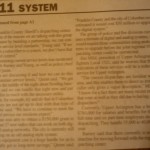ThisWeek UA 04/21/2011
As local budgets tighten under falling state and local revenues, ways to centralize services are being explored in every city department. Emergency services dispatching is one area where Upper Arlington hopes to find long-term savings.
On March 30, Norwich Township Fire Department and the Hilliard Division of Police, both of which serve Hilliard residents, hosted a meeting to begin discussion with the Dublin Police Department, Washington Township Fire Department (serving Dublin residents), Worthington police and fire and Upper Arlington police and fire about the creation of a joint regional 911 dispatching center.
“This was one of multiple meetings taking place around common needs between communities and a desire to serve our constituents in a fiscally conscious, responsible way,” Upper Arlington City Manager Virginia Barney said.
Barney participated in the March 30 meeting, and she said she believes that there is a chance for long-term savings if the city can overcome the upfront costs.
At issue is the cost of conversion to digital radio equipment, build-out of a physical location and the associated system infrastructure.
The departments that participated in this preliminary discussion currently all utilize joint 911 dispatching centers; meaning that both police and fire services are dispatched by the same group of 911 operators.
In most previously designed municipal and regional dispatching systems, police and fire are separate, because, historically, fire departments fell under the township while police departments fell under a municipality.
“The concept is very preliminary right now,” Upper Arlington Fire Chief Jeff Young said. “[The communities represented at the March 30 meeting] all have a similar, high level of service delivery as we do in UA, which is going to be important if we move forward with this.”
Another option available to communities looking to outsource their 911 dispatch centers is to become a subscriber community to the Franklin County Sheriff’s dispatching center.
“One of the reasons we are talking with this group is because, by building a partnership we can control the service level standards,” Young said. “If we are just a subscriber to a system, we don’t have that level of control.”
Maintaining current service levels was mentioned by both Barney and Young, as well as Police Chief Brian Quinn.
“We are discussing if and how we can do this and maintain service levels,” Quinn said. “We get calls in the middle of the night about flooding basements and we can handle that right now and put the caller in touch with the necessary utility; but, for example, try and do that in Columbus and they are not setup to deal with that type of call. We have to continue to meet the level of service our residents expect.”
Quinn was able to obtain a $150,000 grant to purchase 27 new radios that are able to work on both digital and analog networks; Upper Arlington is currently still operating on an old analog style system.
“The equipment cost is a huge hurdle for us to eventually get to long-term savings,” Quinn said. “Franklin County and the City of Columbus recently estimated it would cost $50-million to upgrade to the digital system.”
The group of police and fire divisions currently uses a mixture of digital and analog systems, which would require those communities using analog systems to upgrade before the joint regional 911 dispatching center could be operational.
Jim Mild, president of Upper Arlington Firefighters Local 1521, said he worries that the centralization of these services will be a reduction in service for Upper Arlington.
“The current dispatchers are familiar with the area, and this enables them to direct us even if the caller only gives a vague description,” Mild said. “I know for a fact there are many recent examples that went as well as they did due to having our own dispatchers.”
Currently, Upper Arlington has a budget of $780,000 for salaries and benefits for the seven full-time and six part-time employees involved in dispatching. These employees handle approximately 35,000 to 40,000 calls a year.
Barney said that there currently is no defined timeline for moving forward with the regional dispatching center.

